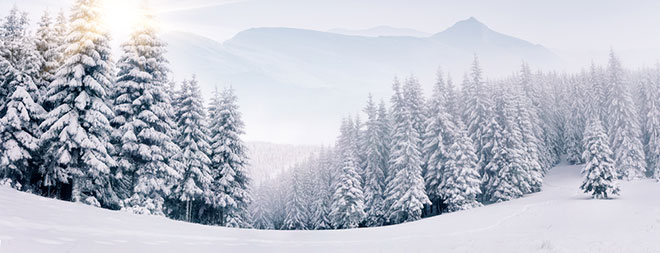Forest Snow Can Melt Faster Than Flakes In Open Fields

(Inside Science) -- As fresh snow turns us into grumbling commuters or weekend skiers, consider that those flakes are more than a winter wonder. Melted snow, in many parts of the world, becomes the water people drink year-round.
Seasonal snow replenishes streams, creeks and groundwater when it melts in the spring; how long this frozen reservoir of water lasts strongly influences a region's water supply during drier months, especially in areas like western Washington state.
Tree cover that obscures spring sunshine might be expected to retain snow longer. But recent research, published in the journal Water Resources Research, suggests that in some areas, snow melts faster under forests than it does in open spaces. Though researchers -- and snow enthusiasts -- have long known forests affect how long the fat wet piles of snow persist, it wasn't clear precisely how trees made a difference.
"Conventional wisdom is that snow lasts longer under forests, because a lot of studies have been done in colder climates, and that's typically true there," said Susan Dickerson-Lange, a graduate student at the University of Washington, Seattle and co-author of the new study.
To identify a possible pattern across both cold and balmier winters, the authors combed through existing research on how forests affect snow. In studies from all over the world, they found a surprising connection between tree cover and snowmelt times.
"We found that in sites with warmer winter temperatures, snow tends to last longer in open sites than under trees," Dickerson-Lange said. The difference was as big as two weeks in some locations.
"We were rather surprised to find this because there are so many local effects that we weren't looking at in that relationship," she added. Quicker melting in forests was also unrelated to the "tree well phenomenon" familiar to skiers -- the well of soft snow that forms around a tree trunk sheltered by branches.
By incorporating global data on temperature, precipitation and wind speed, the team's model considered energy coming from the sun at different times of the year, and how that might be blocked or shaded by trees. Trees became key players in melting snow in warmer locations, they found.
In colder places like Colorado, snow still lasts longer in forests, which protect it from sun and wind, according to Dickerson-Lange. But in maritime climates like western Washington or California, the air itself is much warmer.
"It's a pretty intuitive finding to those of us who work in the field, but before this, nobody's really shown with data and modeling that this happens," said Timothy Link, a hydrologist at the University of Idaho in Moscow.
Everything that has a temperature -- trees, soil, people, the sun -- emits radiation. Trees, like other objects on the earth, mainly emit long-wave, infrared radiation, while sunlight contains a lot of shorter-wave radiation.
In places where temperatures are already close to water's melting point, the infrared energy can accelerate the melting of snow. Several other factors, such as wind or the incline and steepness of a mountainside can change how long snow cover lasts as well.
"This work challenges conventional wisdom, because most folks out there think of snowmelt as being dominated by short-wave radiation -- which it is with deeper snow and colder environments," said Link. "But this paper shows that in warmer environments it really can be long-wave-radiation-dominated."
Though this study only compared areas with forest cover to those without it, many other subtle effects can influence how long snow cover lasts. One factor the team plans to analyze in future work is how well sparse, deciduous forest cover compares with a dense canopy in preserving snow. Another is the direction a mountain slope faces. South-facing slopes are sunnier in the Northern Hemisphere, so snow tends to last longer on northern sides of mountains.
"On a north-facing slope where sunlight is less of a factor, the energy from trees may have a stronger effect," Dickerson-Lange said.
The researchers hope these findings can help inform forest management decisions. Forests are already being managed to improve water supply, habitats for endangered species, or to prevent fires and the spread of parasites.
In the long term, one of the projected impacts of climate warming is that snow will begin to melt earlier in the year, shifting up to a few weeks. Quicker melting might cause less snow to be accumulated in groundwater reserves.
"This will have an impact on our summer water supply," said Dickerson-Lange. "So we're also looking at whether we can manage forests to mitigate this impact, and how will climate change come into play as we consider forest management decisions in the future."
Jyoti Madhusoodanan is a science writer based in San Jose, Calif. She tweets at @smjyoti.
